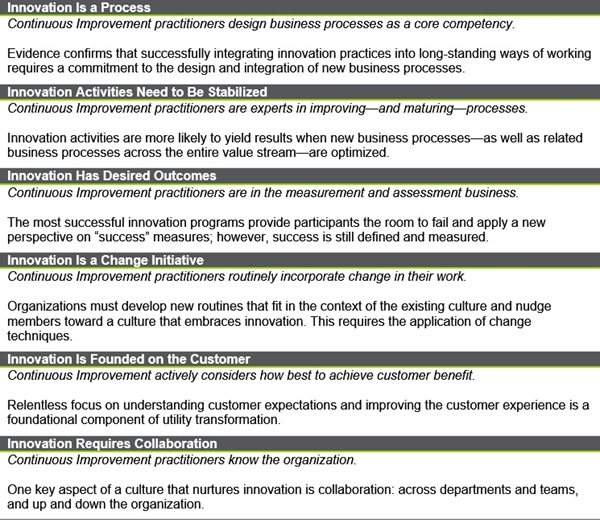- Utility Disruption
- Utility Transformations
- Utility Transformations
- Energy Cloud
- Utility Innovations
- Continuous Improvement
Exploiting Continuous Improvement to Achieve Transformation and Efficiency Goals: Part 2

In my last blog, I discussed the forces at play that are fundamentally transforming the utility industry. At the center of this transformation is the shift in the way electricity is generated and distributed, and the evolution of the traditional relationship among stakeholders across the electrical grid, particularly between utilities and their customers.
In this environment, many utilities are adopting programs focused on innovation, understanding that new and bold thinking is required to successfully address these forces of transformation. In a recent survey, the ability to “market new energy and products and services” and to “radically improve ability to innovate” were among the top-ranked capabilities that utilities should develop to meet future challenges.
Utilities Must Adopt Innovation Practices
However, while many utilities have a familiarity with and muscle memory for Continuous Improvement and the pursuit of incremental quality, fewer are comfortable with the process of rapid innovation. Historically, utilities have not been paid for innovation; the legacy utility business model and regulatory framework has emphasized stability and risk aversion, exemplified by the rate of return financial construct. While the need to deliver safe, reliable, and cost-effective services will always remain at the core of every utility’s responsibility, how those objectives are achieved is undergoing a fundamental evolution that will require innovation in multiple dimensions.
There is much that utilities can learn from companies in the automotive, consumer electronics, publishing, and other sectors when considering how best to successfully adopt innovation practices. The speed of transformation in these and other sectors confirms that innovation efforts must be designed, deployed, and yield real benefits within a new business model. Because adopting an innovation practice is a question of culture change, it is important for utilities to consider the internal resources it has available when seeking to implement an innovation process. And here is the linkage between Continuous Improvement and innovation: Continuous Improvement practitioners can be a driving force for successful adoption of new innovation practices. Here’s how:

(Source: Guidehouse, Inc.)
The core tool kit of Continuous Improvement practitioners can be essential to the design, development, and integration of innovation practices into utility operations—and can help those programs yield results.
In my next blog, I will consider how Continuous Improvement in utilities will need to evolve to meet the demands of a rapidly changing sector. Change management, agile, scrum, “outside in,” and other techniques and ways of thinking will be required to ensure success. These and other topics will be considered at the Change Management for Utilities (West) and Process Excellence for Utilities (West) Conferences.